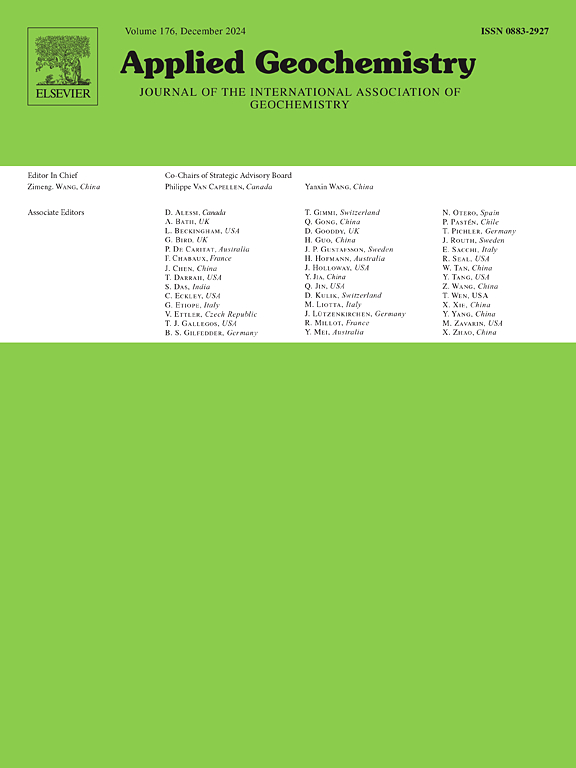Dissolved organic matter sources in urban outfall water before and during rainfall, indicated via its fluorescence fingerprinting
IF 3.4
3区 地球科学
Q1 GEOCHEMISTRY & GEOPHYSICS
引用次数: 0
Abstract
Pollution source identification is the key foundation of urban river water quality management. In this study, fluorescence fingerprinting was employed to analyze changes in dissolved organic matter (DOM) sources in urban river outfalls P1–P3 in Hefei City, China, before and during a rainfall event. The water quality of the outfalls varied before and during rainfall, with an apparent dilution in P2 and a combined effect of urban non-point runoff and dilution in P3. The fluorescent components of the DOM in the outfall water were fulvic acid-like substances C1, terrestrial humic-like substances C2, and tryptophan-like substances C3. The dominant C1 in P1 was diluted by rainfall runoff, decreasing the total fluorescence intensity (FT) of the DOM. The increased FT and proportion of C1 + C2 in P2 during early rainfall indicated runoff inputs, whereas those in P3 increased and decreased thereafter, suggesting that rainfall led to an influx of domestic sewage. Fluorescence fingerprinting analysis indicated that the DOM in P1 originated primarily from rainwater and domestic wastewater treatment plant (WWTP) effluent. The DOM in P2 originated from domestic WWTP effluent pre-rainfall, rainwater, and domestic WWTP effluent during early rainfall and urban non-point runoff during later rainfall, whereas that in P3 originated from domestic sewage before and during early rainfall and urban non-point runoff during later rainfall. Identifying sources of pollution provides a basis for urban outfall and river water quality management before and during rainfall events.
降雨前后城市出水口溶解有机物来源的荧光指纹图谱研究
污染源识别是城市河流水质管理的重要基础。本研究采用荧光指纹技术分析了合肥市城市河流出水口P1-P3在一次降雨前和降雨过程中溶解有机质(DOM)来源的变化。在降雨前和降雨期间,出水口的水质发生了变化,P2明显稀释,P3受到城市非点源径流和稀释的综合影响。出水DOM的荧光成分为黄腐酸样物质C1、陆生腐殖酸样物质C2和色氨酸样物质C3。P1中占优势的C1被降雨径流稀释,降低了DOM的总荧光强度(FT)。降雨前期FT和C1 + C2在P2中所占比例的增加表明径流输入,而降雨后P3中FT和C1 + C2的比例先增加后减少,表明降雨导致了生活污水的流入。荧光指纹分析表明,P1中的DOM主要来源于雨水和生活污水处理厂(WWTP)出水。P2的DOM来源于雨前生活污水、雨水、雨前生活污水和雨后城市非点源径流,P3的DOM来源于雨前和雨后生活污水和雨后城市非点源径流。确定污染源为降雨前和期间的城市排水口和河流水质管理提供了基础。
本文章由计算机程序翻译,如有差异,请以英文原文为准。
求助全文
约1分钟内获得全文
求助全文
来源期刊

Applied Geochemistry
地学-地球化学与地球物理
CiteScore
6.10
自引率
8.80%
发文量
272
审稿时长
65 days
期刊介绍:
Applied Geochemistry is an international journal devoted to publication of original research papers, rapid research communications and selected review papers in geochemistry and urban geochemistry which have some practical application to an aspect of human endeavour, such as the preservation of the environment, health, waste disposal and the search for resources. Papers on applications of inorganic, organic and isotope geochemistry and geochemical processes are therefore welcome provided they meet the main criterion. Spatial and temporal monitoring case studies are only of interest to our international readership if they present new ideas of broad application.
Topics covered include: (1) Environmental geochemistry (including natural and anthropogenic aspects, and protection and remediation strategies); (2) Hydrogeochemistry (surface and groundwater); (3) Medical (urban) geochemistry; (4) The search for energy resources (in particular unconventional oil and gas or emerging metal resources); (5) Energy exploitation (in particular geothermal energy and CCS); (6) Upgrading of energy and mineral resources where there is a direct geochemical application; and (7) Waste disposal, including nuclear waste disposal.
 求助内容:
求助内容: 应助结果提醒方式:
应助结果提醒方式:


